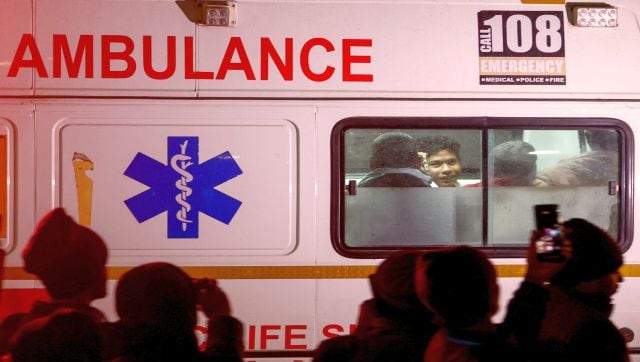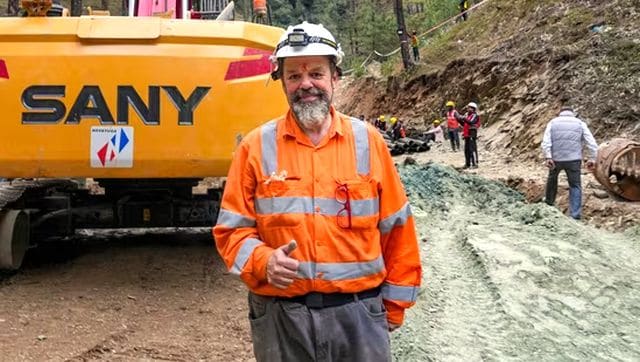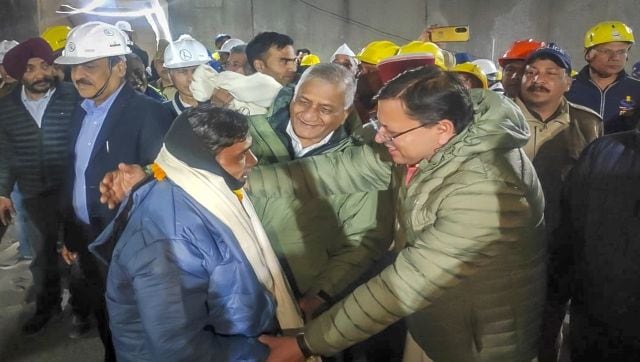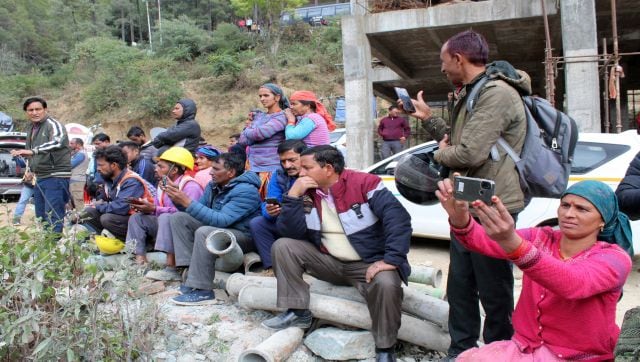After 17 days – 400 hours to be exact – 41 workers trapped inside the tunnel in Uttarakhand’s Silkyara saw the light as they were brought out in a rescue operation that is being dubbed as India’s biggest one to date. As each worker was pulled out of the tunnel, cheer, jubilation broke out at the site while the nation also heaved a collective sigh of relief. Loud cheers and slogans could be heard outside the tunnel as people greeted the ambulances that took the workers to community health centres while locals distributed streets. Uttarakhand chief minister Pushkar Singh Dhami and Union minister V K Singh welcomed the 41 workers with garlands, shook hands and embraced them, while the rescue teams and officials clapped. After being rescued from the tunnel in an operation that saw multiple agencies such as the National Disaster Response Force, the Indian Army, the State Disaster Response Force, Border Roads Organisation, among others collaborate, the workers were sent to hospital for their physical and mental check-ups. Prime Minister Narendra Modi also hailed the efforts of the rescue team to successfully and safely take the workers out. “The success of the rescue operation of our brothers in Uttarkashi is making everyone emotional. I want to say to the friends who were trapped in the tunnel that your courage and patience is inspiring everyone. I wish you all well and good health.” As the workers recuperate and their loved ones celebrate, we take a closer look at the heroes behind this successful mission and the crucial role they played in this operation. Also read: A day-by-day account of the daring Uttarkashi rescue operation Rathole miners Who could have thought that the banned practice of rathole mining would come to the rescue of the labourers trapped inside the collapsed tunnel in Uttarkashi district of Uttarakhand, especially after sophisticated equipment such as the auger drilling machine failed to create a rescue passage. It was on Monday (27 November) that a 12-member team of rathole miners arrived at the Silkyara tunnel to help in the rescue operations. Notably, the practice of rathole mining has been banned in the country in 2014 as it causes environmental degradation and is a threat to the life of miners. Leading the pack of the rathole miners were Feroze Qureshi and Monu Kumar, the first to reach to the trapped labourers inside the tunnel after they cleared the last bit of the rubble inside the structure. While Qureshi hails from Delhi, Kumar hails from Uttar Pradesh. Speaking later, Qureshi said that when they reached the last portion of the debris, the labourers could hear them. “The labourers thanked and hugged me. They also lifted me on their shoulders,” Qureshi, an employee of the Delhi-based Rockwell Enterprises, was quoted as saying.
“We are very happy that we were part of this historic operation,” added Kumar. Later during the media briefing, member of the National Disaster Management Authority, Lt General Syed Ata Hasnain (retired) when asked about using rat-hole mining techniques responded, “Rat-hole mining may be illegal but a rat-hole miner’s talent and experience is being used,” he said. “This is a special situation where we have to save lives. They are technicians and we are using their skills and their capabilities to rescue the workers,” another official added to Lt General Hasnain’s point. [caption id=“attachment_13443422” align=“alignnone” width=“640”] An ambulance carries survivors as rescue operations are underway to rescue trapped workers after a tunnel collapsed, in Uttarkashi. Reuters[/caption] Lt General Syed Ata Hasnain (retired), NDMA To carry out a rescue operation that had multiple agencies involved and the lives of 41 people at risk, is no small task. But Lt General Syed Ata Hasnain (retired), a member of the National Disaster Management Agency (NDMA), rose to the occasion. Overseeing the operations and coordinating between agencies, Lt General Hasnain maintained a cool and collected demeanour even though setbacks kept affecting the timeline of getting the trapped workers out. For the unaware, Lt Gen Hasnain was formerly a member of the GOC 15 corps of the Indian Army, deployed in Srinagar. He has served seven tours in Jammu and Kashmir, decorated in almost of them and knows the conflict comprehensively.
Also read: Why India’s tunnel rescue mission has proved so challenging
Speaking of the mission, Lt General Hasnain credited the government for following procedure and also ensuring that they didn’t overplay their hand. He credited the PMO (Prime Minister’s Office) for the efforts and said, “The only message which needs to be realised and communicated is, this has been all of government and all of India operation.”
An ambulance carries survivors as rescue operations are underway to rescue trapped workers after a tunnel collapsed, in Uttarkashi. Reuters[/caption] Lt General Syed Ata Hasnain (retired), NDMA To carry out a rescue operation that had multiple agencies involved and the lives of 41 people at risk, is no small task. But Lt General Syed Ata Hasnain (retired), a member of the National Disaster Management Agency (NDMA), rose to the occasion. Overseeing the operations and coordinating between agencies, Lt General Hasnain maintained a cool and collected demeanour even though setbacks kept affecting the timeline of getting the trapped workers out. For the unaware, Lt Gen Hasnain was formerly a member of the GOC 15 corps of the Indian Army, deployed in Srinagar. He has served seven tours in Jammu and Kashmir, decorated in almost of them and knows the conflict comprehensively.
Also read: Why India’s tunnel rescue mission has proved so challenging
Speaking of the mission, Lt General Hasnain credited the government for following procedure and also ensuring that they didn’t overplay their hand. He credited the PMO (Prime Minister’s Office) for the efforts and said, “The only message which needs to be realised and communicated is, this has been all of government and all of India operation.”
Arnold Dix, tunnelling expert India left no stone unturned to ensure that the 41 trapped labourers are rescued. They approached several international experts for their help and among those was Arnold Dix, an Australian, who has garnered acclaim across the globe for his expertise. [caption id=“attachment_13443432” align=“alignnone” width=“640”] Arnold Dix, who heads the Geneva-based International Tunnelling and Underground Space Association (Geneva), was present at the accident spot for days providing his technical know-how in the rescue operations. ANI[/caption] Dix, who heads the Geneva-based International Tunnelling and Underground Space Association (Geneva), is known for taking legal, environmental, political and ethical risks related to underground construction. Prof Dix specialises in underground and transportation infrastructure – from construction risk to more technical issues associated with actual safety performance from an operational safety perspective, according to Victorian Bar. He also provides advice on risks associated with underground construction. His career over the three decades has seen a unique hybrid of engineering, geology, law and risk management matters. Dix has been a part of the Silkyara tunnel rescue since 20 November and providing technical expertise on the matter. On Tuesday, Dix also joined hands with local spiritual leaders in prayer for the safe evacuation of 41 construction workers.
Arnold Dix, who heads the Geneva-based International Tunnelling and Underground Space Association (Geneva), was present at the accident spot for days providing his technical know-how in the rescue operations. ANI[/caption] Dix, who heads the Geneva-based International Tunnelling and Underground Space Association (Geneva), is known for taking legal, environmental, political and ethical risks related to underground construction. Prof Dix specialises in underground and transportation infrastructure – from construction risk to more technical issues associated with actual safety performance from an operational safety perspective, according to Victorian Bar. He also provides advice on risks associated with underground construction. His career over the three decades has seen a unique hybrid of engineering, geology, law and risk management matters. Dix has been a part of the Silkyara tunnel rescue since 20 November and providing technical expertise on the matter. On Tuesday, Dix also joined hands with local spiritual leaders in prayer for the safe evacuation of 41 construction workers.
And it seems that his science and spirituality came together and helped him keep his vow of getting the workers out by Christmas. And his one message now that the operations are complete – “The mountain has told us one thing, that is to be humble.” He added, “It’s been my honour to serve, and as a parent, it’s been my honour to help out all the parents getting their children home. Remember in the beginning I said, 41 people home, and no one gets hurt by Christmas. Christmas is coming early… We were calm, and we knew exactly what we wanted. We worked as a wonderful team. India has the best engineers… It was just a joy to be part of this successful mission. I have to go to the temple because I promised to say thank you for what happened. If you haven’t noticed, we have just witnessed a miracle.” [caption id=“attachment_13443442” align=“alignnone” width=“640”] Mos VK Singh along with CM Pushkar Singh Dhami greet rescued workers coming out of the collapsed Silkyara Tunnel, in Uttarkashi district. PTI[/caption] General VK Singh (retired), Minister of State for Road Transport & Highways MoS VK Singh has been a constant presence at the tunnel ever since tragedy befell the site. On Tuesday night, he stood firm awaiting the workers as they were brought out one by one from the Silkyara tunnel. He, along with Chief Minister Pushkar Singh Dhami welcomed the workers with garlands and hailed their grit and determination for not losing hope inside the tunnel.
Also read: The moment the 41 workers at the collapsed Uttarkashi tunnel were freed
Prime Minister Narendra Modi in his 15-minute phone call with the rescued labourers also praised Singh for his efforts, saying, “VK Singh was there the whole time. He showed his Army training and discipline.” Prior to his political stint, he served in the Indian Army and also served as the Chief of Army Staff (COAS) from 2010 to 2012. [caption id=“attachment_13443462” align=“alignnone” width=“640”]
Mos VK Singh along with CM Pushkar Singh Dhami greet rescued workers coming out of the collapsed Silkyara Tunnel, in Uttarkashi district. PTI[/caption] General VK Singh (retired), Minister of State for Road Transport & Highways MoS VK Singh has been a constant presence at the tunnel ever since tragedy befell the site. On Tuesday night, he stood firm awaiting the workers as they were brought out one by one from the Silkyara tunnel. He, along with Chief Minister Pushkar Singh Dhami welcomed the workers with garlands and hailed their grit and determination for not losing hope inside the tunnel.
Also read: The moment the 41 workers at the collapsed Uttarkashi tunnel were freed
Prime Minister Narendra Modi in his 15-minute phone call with the rescued labourers also praised Singh for his efforts, saying, “VK Singh was there the whole time. He showed his Army training and discipline.” Prior to his political stint, he served in the Indian Army and also served as the Chief of Army Staff (COAS) from 2010 to 2012. [caption id=“attachment_13443462” align=“alignnone” width=“640”] People watch rescue operations at the site of an under-construction road tunnel that collapsed in Silkyara in Uttarakhand. AP[/caption] The PMO Last but not the least, the Prime Minister’s Office played a crucial role in the rescue efforts. Officials from the PMO seamlessly helped in maintaining proper coordination between the various agencies involved. From Deputy Secretary Mangesh Ghildiyal to Principal Secretary to the Prime Minister, Dr P K Mishra, they were all involved in Silkyara tunnel rescue operations – on the site and from Delhi. On 27 November, Mishra visited the spot and took stock of the situation. He also interacted with trapped workers through the communication line and assured them of their safe rescue. If it wasn’t for these people and the many more who were involved – Indian Express reports that At least 652 government employees were deployed in the rescue operation – perhaps the operation wouldn’t have been successful and the trapped workers wouldn’t have been rescued. We salute these heroes for their determination, grit and persistence, who remained undeterred in the face of many setbacks in rescuing the 41 trapped labourers. With inputs from agencies
People watch rescue operations at the site of an under-construction road tunnel that collapsed in Silkyara in Uttarakhand. AP[/caption] The PMO Last but not the least, the Prime Minister’s Office played a crucial role in the rescue efforts. Officials from the PMO seamlessly helped in maintaining proper coordination between the various agencies involved. From Deputy Secretary Mangesh Ghildiyal to Principal Secretary to the Prime Minister, Dr P K Mishra, they were all involved in Silkyara tunnel rescue operations – on the site and from Delhi. On 27 November, Mishra visited the spot and took stock of the situation. He also interacted with trapped workers through the communication line and assured them of their safe rescue. If it wasn’t for these people and the many more who were involved – Indian Express reports that At least 652 government employees were deployed in the rescue operation – perhaps the operation wouldn’t have been successful and the trapped workers wouldn’t have been rescued. We salute these heroes for their determination, grit and persistence, who remained undeterred in the face of many setbacks in rescuing the 41 trapped labourers. With inputs from agencies
)